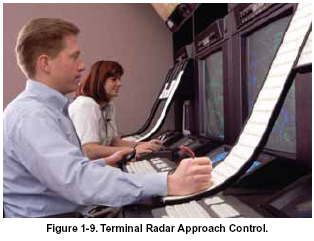 |
|
| INSTRUMENT PROCEDURES HANDBOOK |
|
AIR ROUTE TRAFFIC CONTROL CENTER A Center’s primary function is to control and separate air traffic within a designated airspace, which may cover more than 100,000 square miles, may span several states, and extends from the base of the underlying controlled airspace up to Flight Level (FL) 600. There are 21 Centers located throughout the U.S., each of which is divided into sectors. Controllers assigned to these sectors, which range from 50 to over 200 miles wide, guide aircraft toward their intended destination by way of vectors and/or airway assignment, routing aircraft around weather and other traffic. Centers employ 300 to 700 controllers, with more than 150 on duty during peak hours at the busier facilities. A typical flight by a commercial airliner is handled mostly by the Centers. TERMINAL RADAR APPROACH CONTROL Terminal Radar Approach Control (TRACON) controllers work in dimly lit radar rooms located within the control tower complex or in a separate building located on or near the airport it serves. [Figure 1-9] Using radarscopes, these controllers typically work an area of airspace with a 50-mile radius and up to an altitude of 17,000 feet. This airspace is configured to provide service to a primary airport, but may include other airports that are within 50 miles of the radar service area. Aircraft within this area are provided vectors to airports, around terrain, and weather, as well as separation from other aircraft. Controllers in TRACONs determine the arrival sequence for the control tower’s designated airspace.
Controllers in this type of facility manage aircraft operations on the ground and within specified airspace around an airport. The number of controllers in the tower varies with the size of the airport. Small general aviation airports typically have three or four controllers, while larger international airports can have up to fifteen controllers talking to aircraft, processing flight plans, and coordinating air traffic flow. Tower controllers manage the ground movement of aircraft around the airport and ensure appropriate spacing between aircraft taking off and landing. In addition, it is the responsibility of the control tower to determine the landing sequence between aircraft under its control. Tower controllers issue a variety of instructions to pilots, from how to enter a pattern for landing to how to depart the airport for their destination. FLIGHT SERVICE STATIONS Flight Service Stations (FSSs) and Automated Flight Service Stations (AFSSs) are air traffic facilities which provide pilot briefings, en route communications and VFR search and rescue services, assist lost aircraft and aircraft in emergency situations, relay ATC clearances, originate Notices to Airmen, broadcast aviation weather and NAS information, receive and process IFR flight plans, and monitor navigational aids (NAVAIDs). In addition, at selected locations, FSSs/AFSSs provide En route Flight Advisory Service (Flight Watch), take weather observations, issue airport advisories, and advise Customs and Immigration of transborder flights. Pilot Briefers at flight service stations render preflight, in-flight, and emergency assistance to all pilots on request. They give information about actual weather conditions and forecasts for airports and flight paths, relay air traffic control instructions between controllers and pilots, assist pilots in emergency situations, and initiate searches for missing or overdue aircraft. FSSs/AFSSs provide information to all airspace users, including the military. In October 2005, operation of all FSSs/AFSSs, except those in Alaska, was turned over to the Lockheed Martin Corporation. In the months after the transition, 38 existing AFSSs are slated to close, leaving 17 “Legacy” stations and 3 “Hub” stations. Services to pilots are expected to be equal to or better than prior to the change, and the contract is expected to save the government about $2.2 billion over ten years. FLIGHT PLANS Prior to flying in controlled airspace under IFR conditions or in Class A airspace, pilots are required to file a flight plan. IFR (as well as VFR) flight plans provide air traffic center computers with accurate and precise routes required for flight data processing (FDP1). The computer knows every route (published and unpub-lished) and NAVAID, most intersections, and all airports, and can only process a flight plan if the proposed routes and fixes connect properly. Center computers also recognize preferred routes and know that forecast or real-time weather may change arrival routes. Centers and TRACONs now have a computer graphic that can show every aircraft on a flight plan in the U.S. as to its flight plan information and present position. Despite their sophistication, center computers do not overlap in coverage or information with other Centers, so that flight requests not honored in one must be repeated in the next. |
 CONTROL TOWER
CONTROL TOWER